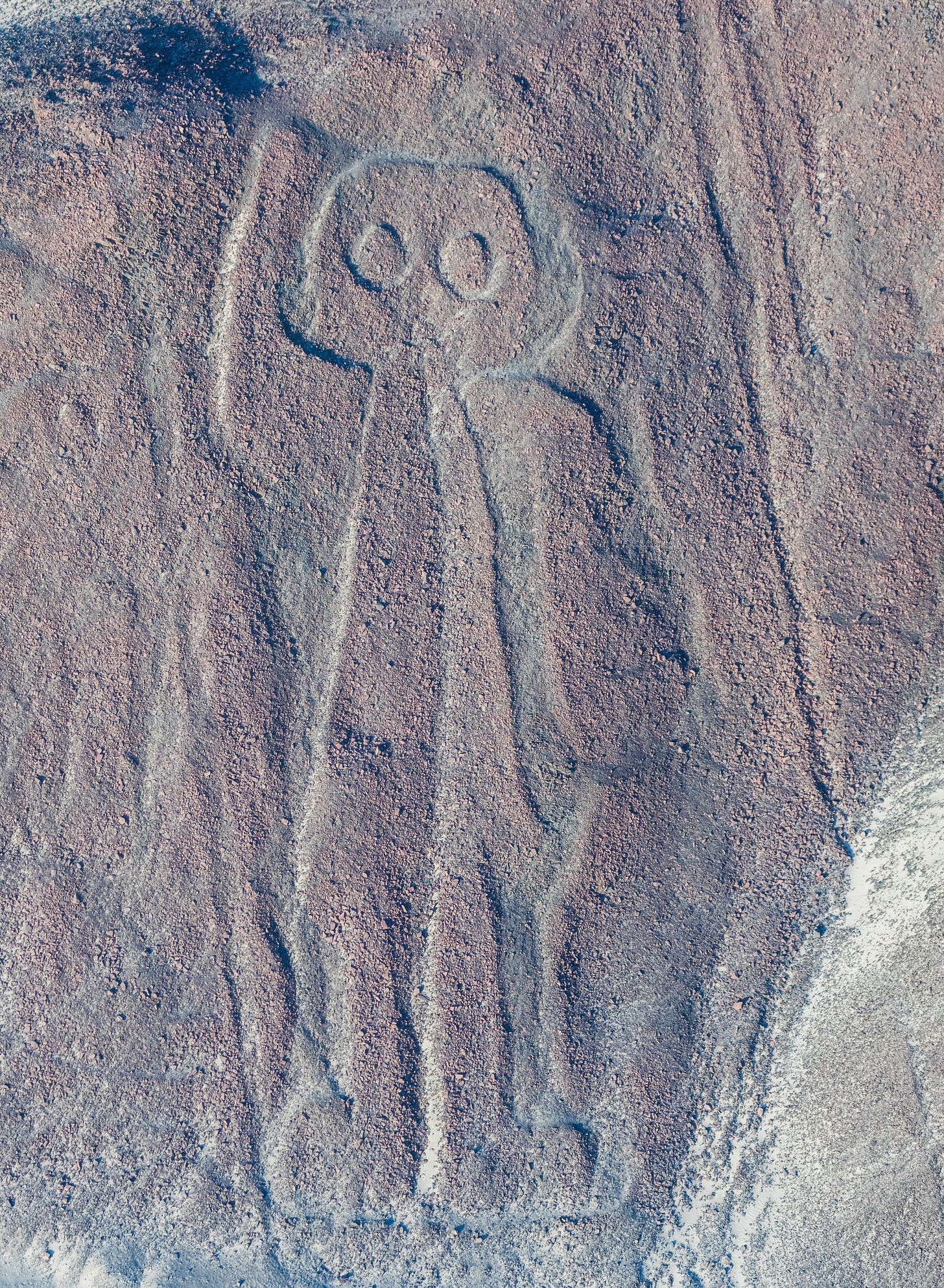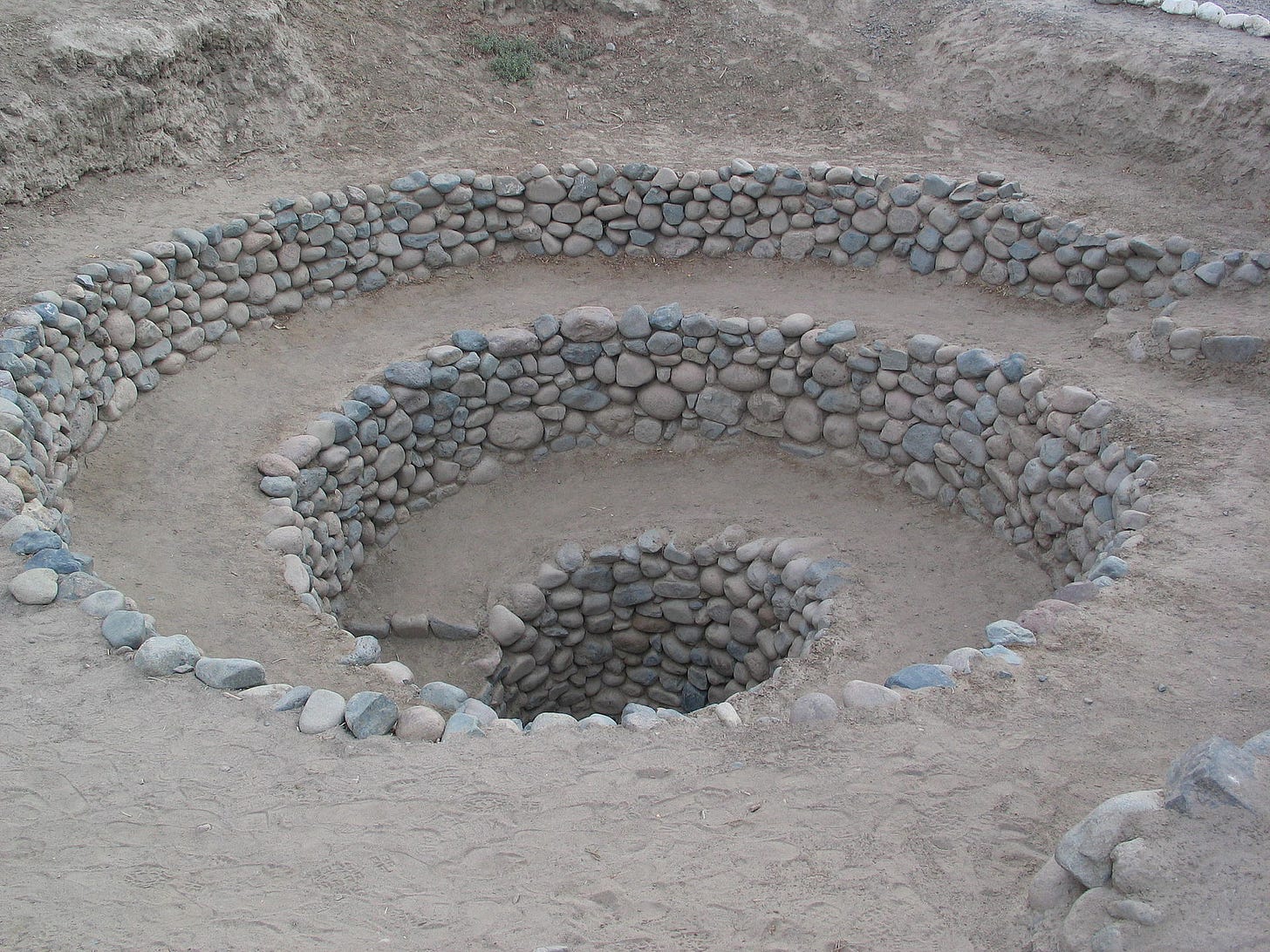In my last post, I talked about a philosopher who, in the early 19th century, vividly imagined what it’d feel like to fly over civilization in an airplane, looking down. It made me start thinking about the Nazca Lines. Nazca is a desert in Peru. About two thousand years ago, a people known only to archaeology etched hundreds of long lines into the rock there. The longest go for about 400 yards, and they intersect with others. Modern people mostly guessed they were trail markers, or roads that had been mostly worn away. Until one day, someone happened to fly over one in an airplane.
Hiiiiiii!
Turns out they’re all line drawings of humans and critters. It’s just that they only look like drawings when you’re in the air above them.
(The first one to be seen from the air was a bird, actually. But it should’ve been this one. I can even persuade myself that I see a Mona Lisa smile.)
We moderns will probably never solve this mystery. We have a pretty good idea how they made these, but why? Why make art that no human could see?
Since we’ll never know—here are two mutually incompatible explanations I came up with. I believe them both.
Puzzle Quest
“You’re not an adult until you’ve found yourself.” That’s what they tell you when you ask for permission to raise children, or to go on a dangerous hunt, or to help design a new aqueduct, or to lead a ceremony, or whatever other ambition you find in yourself. Eventually, you come to the elders and ask them what this means. “How do I find myself?” The next morning, the elders take you out into the desert, deeper than you normally go. You might be alone, but usually a group of friends, the ones who want to collaborate in an adult project, all come at once. They show you one of the lines. “Walk this path,” they say. “Until you know where you are. Then come and tell us. If you’re right, you’re an adult now. If you’re wrong, we’ll take you to another path next month.”
You know where you are. They didn’t blindfold you, and you’re not that far from home. But it can’t be that simple. You walk along the line. You find other paths branching off of it, and follow them. Sometimes you leave the path and climb a dune, trying to see where they lead, but you can only see fragments and they all look like dead ends. The sun rises, and you curse it. You walk along the same lines again and again, getting hotter and wearier. Why is the sun so punishing out here? Why is it doing this to you?
But that’s not fair to the sun. You’re doing this to yourself. Nobody made you try to be an adult. You decided you wanted to rise, just as the sun did. And that’s when, in that unexpected sense of empathy and the delirium of the heat, for one moment you are the sun. What does the sun see?
You return to the elders. “A pelican. That’s where I was.” And now you can be trusted. Adults are those who know how to see from another’s eyes, who can find themselves in the sun.
(To become an elder, you have to solve all the lines, which is the work of a lifetime. Most don’t, but enough do that the sun’s-eye view of each place is known to the next generation.)
Extrapolation
“We are the best of all peoples.” It’s one of those sayings we grew up hearing, because our parents and grandparents grew up hearing it. It’s used in speeches, ceremonies, and jokes. “We are the best of all peoples, so why can’t we get through a full day without someone farting in public?”
It feels like a centerstone, the small piece that holds up so much, like the stone at the center of a stable and mighty spiral wall. We are the best of all peoples, so we must take care of strangers from lesser peoples, let them use our water. We are the best of all peoples, that’s why we must band together to drive off these bandits who would scatter us. We are the best of all peoples, that’s why we travel from coast to forest to desert—nobody else could, so we must.
So it’s a problem when someone starts questioning it. “I grew up fatter and stronger than my parents, because they could feed me better than their parents fed them,” she says at a feast one day. “And my sister figured out how to whittle a little bit faster than anyone we knew. We keep getting better with each new life. So how can we be the best of all peoples, when our children will be better than us? And their children better, and theirs, until one day we are scattered and forgotten, and new peoples arise that are better still.”
Nobody has a good answer, so we just tell her to stop asking dangerous questions. And she does, but at the next feast someone else insists on asking her question again. We start to worry. What if this question, this blow to our centerstone, is what scatters us? What if we forget to be kind, or strong, or awesome, when we’ve always said it’s because we’re the best?
Many feasts later, the original questioner speaks again. Some of us cringe, but we’re all rapt. “I have a different question,” she says. “What is the greatest thing anyone could ever do?”
We all have different answers, which we argue for eloquently, but when a little boy gives an answer, we all immediately know it’s right. “Fly like a bird!” he says. Someday, somehow, people will fly, and surely those people will be the best of all.
“Okay,” she says, as soon as it’s clear we all agree. “So how do we join those people? We can’t fly, or teach our children how to fly. They may not even know we existed. How can we be one with them? How can we wave to them across time, the way you can wave to someone far away? How can we make them feel the same awe, thinking of us, that we do thinking of them?”
For the rest of the feast we share ideas. At the next, we share plans. And for each feast after that, for a long time, we gradually make our plans better and better, until, at last, we’re ready.







Wow! This is brilliant, beautiful, moving. Thank you for your insight!